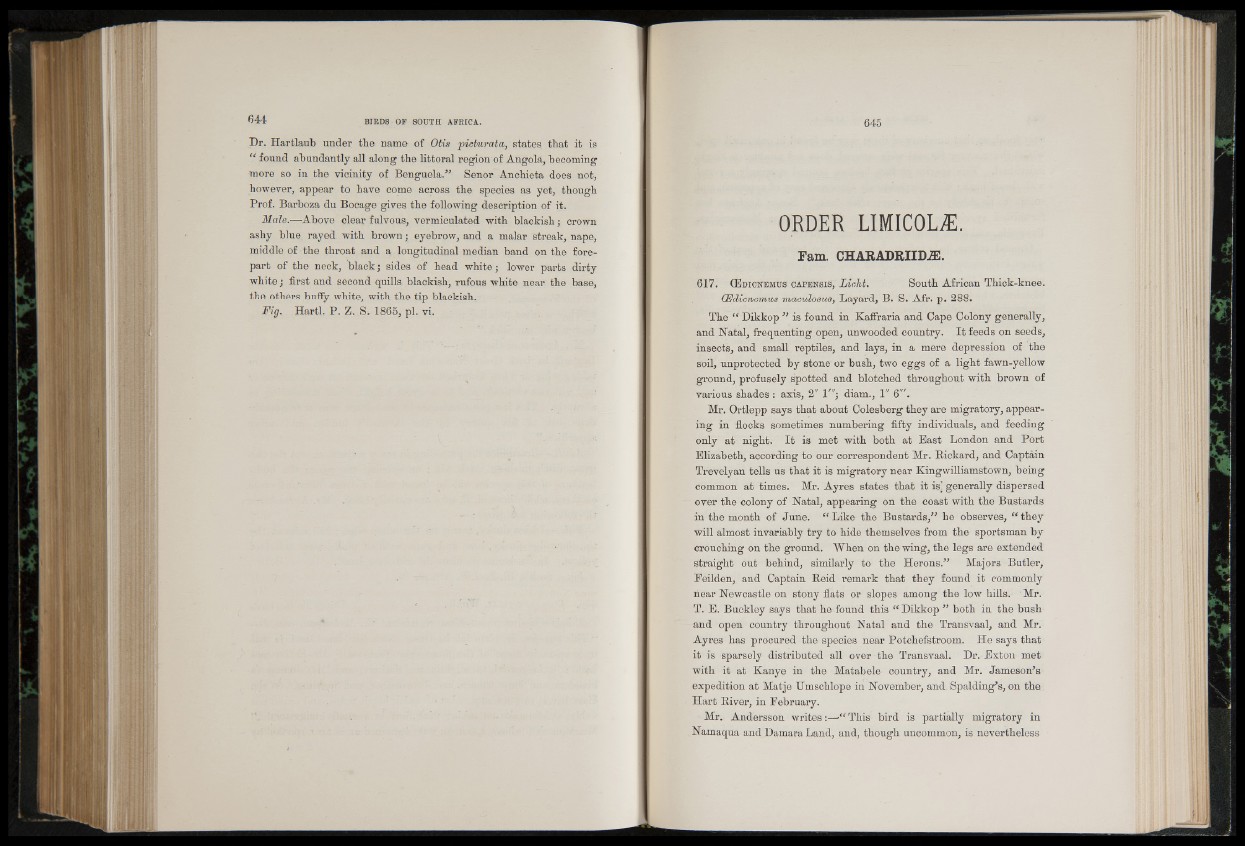
Dr. Hartlaub under the name of Otis picturata, states that it is
“ found abundantly all along the littoral region of Angola, becoming
more so in the vicinity of Benguela.” Senor Anchieta does not,
however, appear to have come across the species as yet, though
Prof. Barboza du Bocage gives the following description of it.
Male.—Above clear fulvous, vermiculated with blackish ,• crown
ashy blue rayed with brown; eyebrow, and a malar streak, nape,
middle of the throat and a longitudinal median band on the forepart
of the neck, black; sides of head white; lower parts dirty
white; first and second quills blackish, rufous white near the base,
the others buffy white, with the tip blackish.
Fig. Hartl. P. Z, S. 1865, pi. vi.
ORDER LIMICOLAl.
Fam. CHARADRIIDiE.
617. C E d i c n e m u s c a p e n s i s , LicM. South African Thick-knee.
CEdicnemus maculosus, Layard, B. S. Afr. p. 288.
The “ Dikkop ” is found in Kaffraria and Cape Colony generally,
and Natal, frequenting open, unwooded country. It feeds on seeds,
insects, and small reptiles, and lays, in a mere depression of the
soil, unprotected by stone or bush, two eggs of a light fawn-yellow
ground, profusely spotted and blotched throughout with brown of
various shades: axis, 2" 1'"; diam., 1" 6"\
Mr. Ortlepp says that about Colesberg they are migratory, appearing
in flocks sometimes numbering fifty individuals, and feeding
only at night. I t is met with both at East London and Port
Elizabeth, according to our correspondent Mr. Rickard, and Captain
Trevelyan tells us that it is migratory near Kingwilliamstown, being
common at times. Mr. Ayres states that it is’ generally dispersed
over the colony of Natal, appearing on the coast with the Bustards
in the month of June. “ Like the Bustards/'’ he observes, “ they
will almost invariably try to hide themselves from the sportsman by
crouching on the ground. When on the wing, the legs are extended
straight out behind, similarly to the Herons.” Majors Butler,
Eeilden, and Captain Reid remai’k that they found it commonly
near Newcastle on stony flats or slopes among the low hills. ' Mr.
T. E. Buckley says that he found this “ Dikkop ” both in the bush
and open country throughout Natal and the Transvaal, and Mr.
Ayres has procured the species near Potchefstroom. He says that
it is sparsely distributed all over the Transvaal. Dr. Exton met
with it at Kanye in the Matabele country, and Mr. Jameson’s
expedition at Matje Hmschlope in November, and. Spalding’s, on the.
Hart River, in February.
Mr. Andersson writes:—“ This bird is partially migratory in
Namaqua and Damara Land, and, though uncommon, is nevertheless